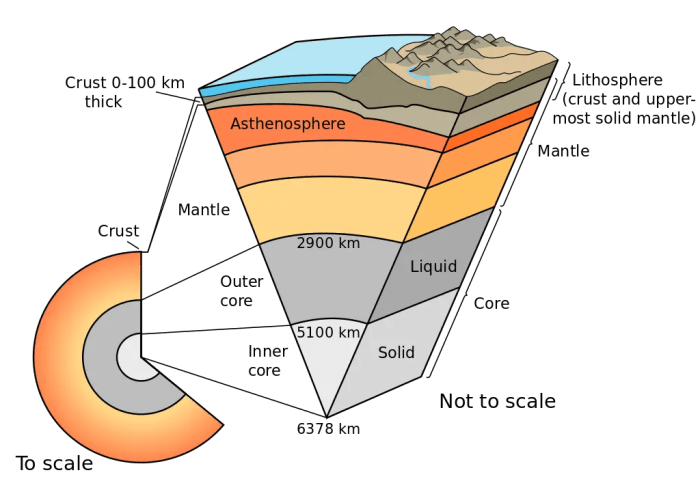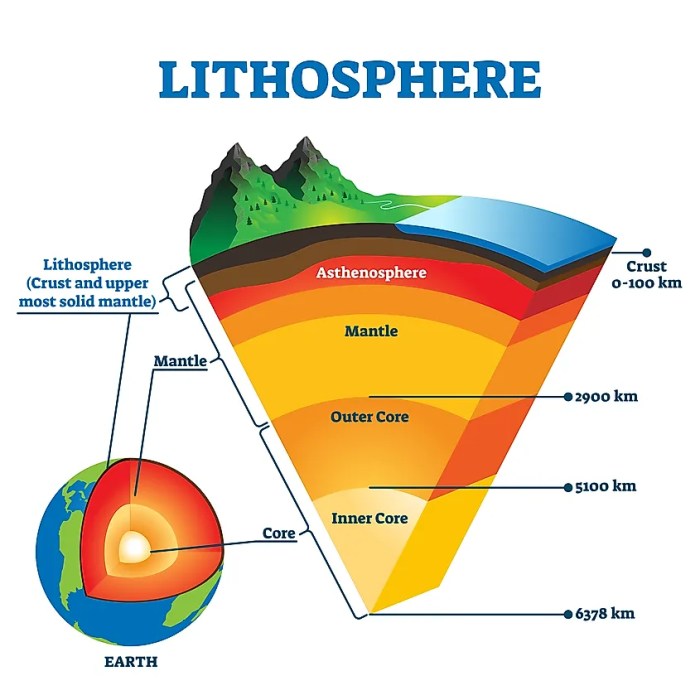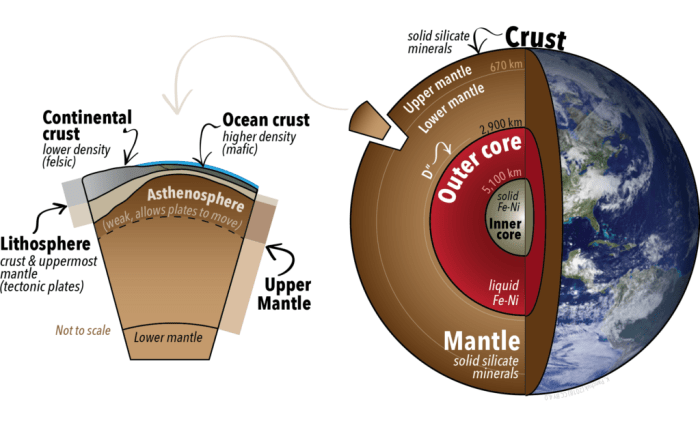Sort statements as being true of the lithosphere or asthenosphere – In this article, we will sort statements as being true of either the lithosphere or asthenosphere. The lithosphere is the rigid, outermost layer of the Earth, while the asthenosphere is the layer beneath it that is characterized by its plastic behavior.
We will explore the key differences between these two layers in terms of their composition, density, thickness, and physical properties.
We will also discuss the role of the lithosphere and asthenosphere in various geological processes and phenomena, such as plate tectonics, earthquakes, and volcanoes. By the end of this article, you will have a clear understanding of the lithosphere and asthenosphere and their importance in the Earth’s systems.
Lithosphere vs. Asthenosphere: A Comparative Overview: Sort Statements As Being True Of The Lithosphere Or Asthenosphere

The lithosphere and asthenosphere are two distinct layers within the Earth’s mantle. They differ in their composition, density, thickness, and physical properties.
| Characteristic | Lithosphere | Asthenosphere |
|---|---|---|
| Composition | Solid rock (mostly oceanic and continental crust) | Semi-solid rock (mostly mantle rock) |
| Density | High (3.0-3.5 g/cm3) | Lower (3.2-3.4 g/cm3) |
| Thickness | 50-100 km | 100-200 km |
| Physical Properties | Rigid and brittle | Semi-solid and plastic |
Physical Properties of the Lithosphere
The lithosphere is the rigid, outermost layer of the Earth’s mantle. It is composed of solid rock, primarily oceanic and continental crust. The lithosphere is divided into tectonic plates, which move slowly over the asthenosphere below.
- Rigid and brittle: The lithosphere is rigid due to the strong bonds between its constituent minerals. This rigidity allows it to resist deformation and maintain its shape.
- Tectonic plates: The lithosphere is divided into a number of tectonic plates, which move over the asthenosphere. Plate movements are driven by convection currents within the asthenosphere.
- Isostasy: Isostasy is the concept that the lithosphere floats on the asthenosphere, much like a boat floats on water. This is due to the fact that the lithosphere is less dense than the asthenosphere.
Physical Properties of the Asthenosphere
The asthenosphere is the semi-solid, plastic layer of the Earth’s mantle that lies beneath the lithosphere. It is composed of partially molten rock, which gives it its plastic behavior.
- Semi-solid and plastic: The asthenosphere is semi-solid due to the presence of partially molten rock. This molten rock allows the asthenosphere to flow and deform under stress.
- Convection currents: Convection currents within the asthenosphere drive the movement of tectonic plates. These currents are caused by the uneven heating of the Earth’s interior.
- Volcanoes and earthquakes: The asthenosphere is the source of magma for volcanoes. It also plays a role in the formation of earthquakes.
Chemical Composition and Mineralogy
The lithosphere and asthenosphere differ in their chemical composition and mineralogy. The lithosphere is composed primarily of oceanic and continental crust, which is rich in silica and alumina. The asthenosphere is composed primarily of mantle rock, which is rich in iron and magnesium.
- Lithosphere: The lithosphere is composed primarily of oceanic and continental crust. Oceanic crust is composed of basalt, which is a dark, fine-grained rock. Continental crust is composed of granite, which is a light-colored, coarse-grained rock.
- Asthenosphere: The asthenosphere is composed primarily of mantle rock. Mantle rock is composed of peridotite, which is a dark, dense rock.
- Differences in composition: The differences in composition between the lithosphere and asthenosphere affect their physical properties. The lithosphere is more rigid and brittle than the asthenosphere due to its higher silica content.
Geologic Processes and Phenomena, Sort statements as being true of the lithosphere or asthenosphere
The lithosphere and asthenosphere are involved in a variety of geologic processes and phenomena. The lithosphere is the site of weathering, erosion, and mountain building. The asthenosphere is the source of magma for volcanoes and the site of earthquake formation.
- Lithosphere: The lithosphere is the site of weathering, erosion, and mountain building. Weathering is the process of breaking down rocks into smaller pieces. Erosion is the process of transporting these pieces away. Mountain building is the process of forming mountains.
- Asthenosphere: The asthenosphere is the source of magma for volcanoes. Magma is molten rock that rises from the asthenosphere to the surface. The asthenosphere is also the site of earthquake formation. Earthquakes are caused by the sudden release of energy when rocks in the asthenosphere break.
- Interaction: The interaction between the lithosphere and asthenosphere influences these processes and phenomena. For example, the movement of tectonic plates in the lithosphere can cause earthquakes and volcanic eruptions.
Importance in Earth’s Systems
The lithosphere and asthenosphere play an important role in Earth’s systems. The lithosphere regulates Earth’s surface temperature and climate. The asthenosphere recycles Earth’s materials.
- Lithosphere: The lithosphere regulates Earth’s surface temperature and climate. The lithosphere absorbs heat from the sun during the day and releases it at night. This helps to moderate Earth’s temperature.
- Asthenosphere: The asthenosphere recycles Earth’s materials. The asthenosphere is the source of magma for volcanoes. When magma erupts, it brings new materials to the surface of the Earth. These materials are then weathered and eroded, and eventually returned to the asthenosphere.
Detailed FAQs
What is the difference between the lithosphere and the asthenosphere?
The lithosphere is the rigid, outermost layer of the Earth, while the asthenosphere is the layer beneath it that is characterized by its plastic behavior.
What is the role of the lithosphere in plate tectonics?
The lithosphere is divided into tectonic plates that move around the Earth’s surface. These plates interact with each other at their boundaries, which can cause earthquakes, volcanoes, and other geological phenomena.
What is the role of the asthenosphere in the formation of volcanoes?
The asthenosphere is the source of magma that rises to the surface and forms volcanoes.


